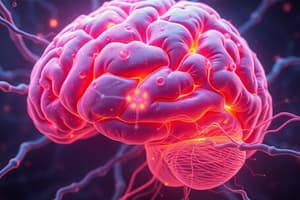Podcast
Questions and Answers
- Excitatory neurotransmitters 'excite' the neuron and cause it to pass the message along, while ______ neurotransmitters block or prevent the message from continuing.
- Excitatory neurotransmitters 'excite' the neuron and cause it to pass the message along, while ______ neurotransmitters block or prevent the message from continuing.
inhibitory
- There are at least 100 ______, including GABA, dopamine, serotonin, norepinephrine, endorphins, and acetylcholine, that play a key role in cognitive functions, pain relief, mood regulation, arousal, and learning.
- There are at least 100 ______, including GABA, dopamine, serotonin, norepinephrine, endorphins, and acetylcholine, that play a key role in cognitive functions, pain relief, mood regulation, arousal, and learning.
neurotransmitters
- Transmission occurs at synapses that form connections between neurons, neuromuscular junctions that connect neurons with muscles, and ______ junctions that connect neurons with glands.
- Transmission occurs at synapses that form connections between neurons, neuromuscular junctions that connect neurons with muscles, and ______ junctions that connect neurons with glands.
neuroglandular
Study Notes
Understanding Neurotransmitters and Neurotransmission
- The nervous system carries messages from one neuron to another, and these messages help in movement, sensation, heart function, and response to internal and external stimuli.
- Neurotransmitters are chemical messengers that transmit signals from a neuron to a target cell across a synapse, which can be a neuron, muscle, or gland cell.
- Neurotransmitters fall into several chemical classes based on their molecular structure, function, and action, such as acetylcholine, biogenic amines, amino acids, excitatory, inhibitory, direct, or neuromodulator.
- The role of neuromodulators is to alter the properties of ion channels in a neuron, while neurotransmitters carry chemical signals from one neuron to another.
- Excitatory neurotransmitters "excite" the neuron and cause it to pass the message along, while inhibitory neurotransmitters block or prevent the message from continuing.
- Neuromodulators can affect a large number of neurons and influence the effects of other neurotransmitters.
- There are at least 100 neurotransmitters, including GABA, dopamine, serotonin, norepinephrine, endorphins, and acetylcholine, that play a key role in cognitive functions, pain relief, mood regulation, arousal, and learning.
- Synaptic transmission is the process by which a transmitter is released from one neuron and diffuses to other neurons or target cells, where it generates a signal that excites, inhibits, or modulates cellular activity.
- Transmission occurs at synapses that form connections between neurons, neuromuscular junctions that connect neurons with muscles, and neuroglandular junctions that connect neurons with glands.
- A synapse transmits nerve impulses from one neuron's axon terminal to the dendrites of the next neuron.
- The action potential is the process by which a "sending" cell communicates with a "receiving" cell through the synapse.
- Understanding neurotransmitters and neurotransmission is essential to understanding the functioning of the nervous system and the body's response to internal and external stimuli.
Studying That Suits You
Use AI to generate personalized quizzes and flashcards to suit your learning preferences.
Description
Test your knowledge on the fascinating world of neurotransmitters and neurotransmission with our quiz! This quiz will challenge your understanding of the molecular structure, function, and action of neurotransmitters, as well as the process of synaptic transmission and the role it plays in cognitive function, pain relief, mood regulation, arousal, and learning. Put your knowledge to the test and see how much you really know about these crucial components of the nervous system!




